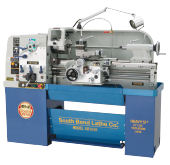South Bend Lathe History
Before the Web, before satellites, before fiber optics, hypertext, and modems, telegraphs linked the world. One cable address known to many at that time was "Twins." If you wired this address, you would reach John and Miles O'Brien, founders of South Bend Lathe Works. The brothers were identical twins who looked so much alike, even their close friends could not tell them apart, despite that one had lost three fingers in an accident.
How Miles lost his fingers is not known. Perhaps he lost them while running one of the lathes the brothers designed, built and tested in the one-room shop they established in 1906 as The South Bend Machine Tool Company. This endeavor was the culmination of 20 years of tool-and-die experience. They were born in Cork County, Ireland in 1868, and were raised by their father after their mother died in childbirth. The family immigrated to Connecticut in the 1870's where John and Miles attended public and parochial schools. At the age of 15, they found jobs at the Stanley Works plant in New England where they began learning their trade. Miles worked for a time under the tutelage of Thomas Edison, until the inventor told the brothers to round out their machine shop experience with engineering courses. They attended Purdue University in West Lafayette, Indiana, then worked at various jobs around the state. At one time, John was hired as a superintendent in a bicycle plant, but it wasn't until a year later the owner discovered Miles actually filled the job, because John already worked in Elkhart, Indiana.
At the age of 35, the brothers decided to set up their own shop, and build a lathe they had been designing since before Miles' days at the Edison Phonograph Company. They rented a one-room shop filled with equipment for $65 a month at the corner of West Washington and Johnson Streets in South Bend, Indiana. At one point, they built an engine used for blowing out boiler tubes for their landlord. When he asked them to make more, they declined. They wanted to concentrate solely on lathes, the most fundamental of machine tools. As a result, the O'Brien's were invited to find another shop in which to make their lathes. So in 1908, they moved into a rented portion of the former Singer Sewing Machine plant on E. Madison Street in South Bend, and became South Bend Lathe Works, to more accurately reflect their product. By 1919, South Bend Lathe Works manufactured 44 sizes of one style of lathe, and by 1930, built 47 percent of the engine lathes in the United States during 1929 and 1930, according to a news report published in 1931, which cited a study by the U.S. Commerce department.
In the quarter century since its founding, South Bend Lathe Works became the largest exclusive manufacturer of metalworking precision lathes in the world, with customers in over 88 countries. The machines were used in every type of industry, in schools, home workshops and large manufacturers from Bermuda to Mali, Indochina, and Siberia. South Bend lathes were chosen by engineers and scientists who accompanied Admiral Richard Byrd on his two expeditions into Antarctica. They were used where the finest accuracy was required, "including airplane and radio equipment," according to the South Bend Tribune in 1936. Miles died that year, ending a life-long partnership. Part of their success was their willingness to work as equals. Both had the title "President" on their business cards. One would serve as president, and one as secretary-treasurer, and every two years, they exchanged duties.
Much of their success was due also to their focus on training skilled machinists. John O'Brien wrote "How to Run a Lathe," which sold millions of copies all over the world, as well as manuals on setting up and maintaining lathes. At least 75 percent of the schools and colleges in the United States were using South Bend lathes in their engineering, vocational, and technical departments, according to an early South Bend paper, The New-Times. They also developed and marketed an affordable 9-inch precision lathe for the home workshop, capable of the same accuracy as machines used in industry. Thirty years after two men set out to build one lathe, 475 men and women were employed manufacturing about 100 different styles of lathes ranging in size from nine- to 16-inch swing and bed lengths from two to 14 feet, and 40 different attachments for them. During the World War II years, South Bend Lathe Works not only received government contracts to build lathes, but a Bureau of Ordnance flag, and the prestigious "E" pennant, the highest award bestowed on a manufacturing organzation by the U.S. Navy for outstanding performance on navy contracts. The year following the war's end, John O'Brien died.
Changes continued after the war. In 1959 American Steel, later known as Amsted Industries, of Chicago, Illinois, bought South Bend Lathe Works with its workforce of 360. In the following years, the product line was expanded, and included drilling and tapping machines, and mechanical presses. The company also moved into the old Studebaker plant on Sample Street in South Bend in 1965. Amsted almost closed the plant in 1975, but its 500 employees and city officials applied for an Employee Stock Ownership Plan grant, and made it the largest employee-owned plant in the U.S. The next year, Time magazine reported a financial turn-around for South Bend Lathe Works in an article about Employee Ownership Stock Plans. The article said the boost in productivity was due to economic recovery in the U.S., but that South Bend Lathe might not exist at all, were it not for the ESOP. After several ownership changes, the company is "home" and the desire to succeed has never been greater!
Our product line includes the legendary 10K and Heavy 10 lathes as well as a broad
range of sizes of other lathes that cover all size users up to the heavy industrial
machine shops. Our selection of absolute top quality machines will satisfy the most
discerning owner.
The O'Brien brothers would be proud of today's South Bend Lathe
Co.
A related O'Brien family story: In 1946, the daughter and neice of the O'Brien brothers invented the disposable diaper. Read the full story!

